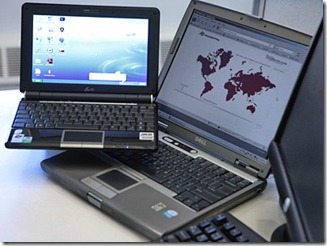 The variety of notebooks is overwhelming and new models are appearing daily. The market is starting to look like this:
The variety of notebooks is overwhelming and new models are appearing daily. The market is starting to look like this:
- Netbooks with 10”-11” screens, powered by Intel’s weak Atom processor, with 1-2Gb of RAM, running the stripped-down Windows 7 Basic. You’ll likely get one from the cell phone carriers, who will practically give them away as long as you sign up for a two-year data plan. They’re smaller than you think – perfect for Internet browsing and checking the mail, but definitely not what you want as your only computer. The next generation will be better, with faster processors and solid state drives. Weight: next to nothing.
- Notebooks with 13-14” screens marketed as “ultralight,” “ultrathin,” ultraportable,” “ultramarine.” Possibly not “ultramarine.” These are the sexy ones with vanishing profiles, impossibly thin and yet equipped with the same processors and storage as their clunkier big brothers. Prices are still quite high, but the market is new and they’ll get cheaper as the novelty wears off. Typically there’s no built-in DVD drive (you can attach an external drive with a USB cable when needed), which means an extra step if you want to watch a movie on the plane. Weight: 3.5-4.5 pounds.
- All the rest of the notebooks in the world, from the 5.5-pound standard models with 15” screens on up to 8-pound behemoths with 17” screens. When you see a really cheap notebook, it’s likely to have a 15” screen and weigh five pounds, more or less. Seems like they all do.
That’s certainly not all! There are tablet PCs with touchscreens, odd hybrids with detachable keyboards, and high-end gaming notebooks. But if you break the market into those three segments, you’ll be pretty close for the next few months.
Tomorrow I’ll show you some of the ultrathin notebooks on the market now!

Trackbacks/Pingbacks